The 18v Li-ion Power Tool Battery Blues
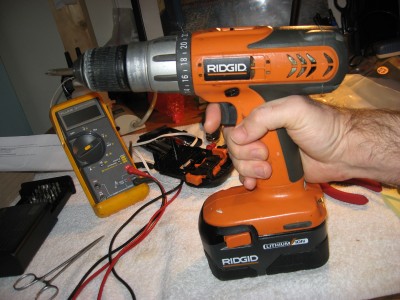
This journey started with the drill you see above. It was my first Ridgid brand power tool; given to me years ago by a good friend. I was suspicious; I knew Ridgid was known for good plumbing equipment but questioned their foray into other tools. Fortunately I was wrong...I loved the drill. Powerful, well balanced, and well built. This is the original 18v model, and I still use it today. It came with a ni-cad battery pack, which lasted for years under heavy usage and poor conditions. It (and the others I bought) finally died though, so I purchased a couple lithium ion (Li-Ion) packs about a year ago.
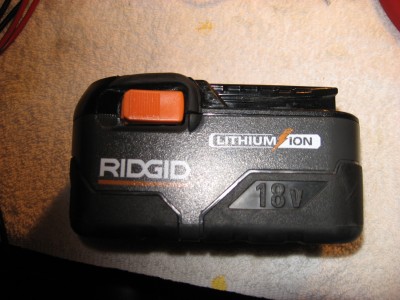
The batteries have been disappointing in a few areas: 1.) expense, 2.) the dreaded 'power cutout' , and 3.) short term and overall longevity.
1.) Yes, Li-Ion packs are pricey. I found out why:

This image shows the battery when opened. As you can see, the view is dominated by circuitry. Here is why all the electronics need to be there: Li-Ion technology isn't as 'tough' Ni-Cad or NiMH. They are very easily damaged by undervoltage or overvoltage conditions (and can catch fire / explode when charging goes wrong) so there must be voltage monitoring and cutoff circuitry. Ridgid and the other manufacturers are in a bind: they want you to be able to grab any battery type and use it with your drill, or pop it in your charger. Unfortunately that means that EACH AND EVERY battery must have an expensive circuit board. They could build the circuit into new drills and chargers instead, but then you lose compatibility with older equipment. So... hence the small fortune for a Li-Ion battery pack
2.) Power 'cut out'
I was used to the old style Ni-Cad battery that I could run until the drill would just barely spin, even when not driving in a screw. The controller circuitry built in to the Li-Ion battery doesn't allow this to happen though... Li-ion cells can be damaged below 3 volts (and once damaged, they often can't recover or be charged again).
I tested the cutoff circuit by running the drill until it suddenly stopped. Metering the cells revealed the cutoff at 17 volts...or 3.4 volts per cell. This is fine; it provides a built-in buffer to make sure nothing happens to your expensive Bosch battery pack. It is pretty damn annoying though.. when you really need to get that last screw in or hole drilled, and the drill doesn't just slow down...it completely stops.
Another interesting fact to note is that Ni-Cad cells can output more amps safely than Li-Ion cells in general. So you may notice that when you are using a high-amp tool such as a circular saw, it doesn't have quite the 'umph' on Li-Ion.
3.) Last but not least, Longevity (both battery usage times, and overall lifespan)
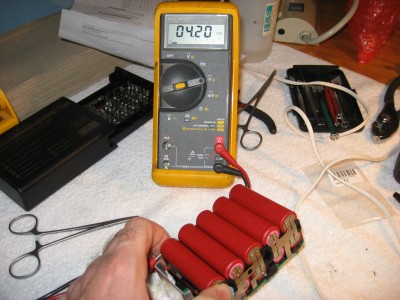
I was disappointed at how long the battery lasts under use. Li-ion is a more energy dense battery than the Ni-cads I was used to. So why wasn't I getting much longer usage? In the image above, you can see the double row of red Li-Ion cells that make up a full size Ridgid 'Max' battery. Each one outputs around 3.7 volts, plus or minus (4.2 v fully charged as in the pic, and around 3 v discharged). It is hard to tell in the pic, but the top and bottom row of cells are connected in parallel; then each set of two cells is connected in series.
- So: 10 cells total , divided by 2 because they are in parallel = 5.
- 5 x 3.7volts per cell set = 18.5 volts which is expected for an '18v' pack.
Hunky-dory, right? But there's a problem: lithium cells in a pack should be charged to the same voltage. One bad , off-balance cell can ruin an entire battery pack. This issue is normally compensated for by 'balancing' the battery....in other words, individual cells are charged independantly to the correct voltage...giving much better performance and longevity. Laptops using Li-ion batteries commonly do this. In the Ridgid pack however, the 10 cells are arranged in sets of two in parallel....making it impossible to properly balance the Max pack. I couldn't even test the cells individually with a multimeter because the endcaps are connected with welds. I would have to bust out tin snips and cut metal to break them apart, and I didn't want to do that. Was the Ridgid charger capable of doing any type of balancing? Was it even charging to full capacity? I did some testing to find out.
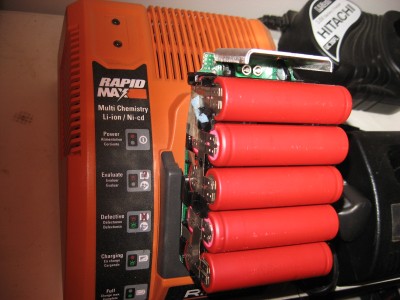
I charged the battery pack fully in the Ridgid charger, and then tested each set of two cells for voltage. Remember, these are sets of two cells as I couldn't easily test individually. Also, because the battery isn't under load, these numbers are somewhat 'educated guesses'.
The voltages: 4.18v 4.17v 4.15v 4.18v 4.15v
As for balancing, they aren't too far apart. Maybe the charger does balance the 5 sets, which is the best it can do. The voltage average is a bit low though....meaning the charger isn't really topping off the battery pack to a full state.
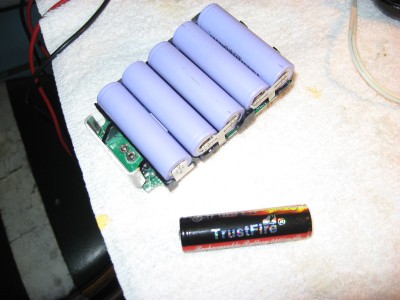
In order to test the charger's ability to balance, I had to open up another battery: the smaller 'starter kit' battery that commonly comes with a tool purchase. It is half the size of the larger 'Max' unit...and has half the cells, as you can see above. Note the different color cells...purple versus red. I suspect a different manufacturer. (Update: these are 18650 size Chinese made Lishen brand cells with 1400 mAh capacity) Shown in size comparison is a Trustfire Li-ion cell. This is an individual size 18650 battery that I use in super bright LED flashlights . It is just slightly longer than the Ridgid cells...probably because the Trustfire has the protection circuitry built in to it.
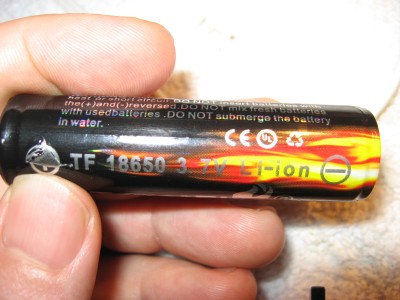
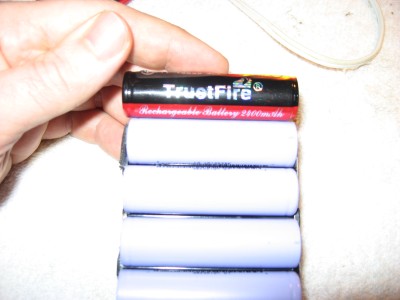
Anyway, the advantage to the purple mini battery is that because there is half the number of cells, they aren't in parallel; just 5 cells in series with the exact same charging / protection circuit board. I could test these cells individually. I drained the entire battery about half way, then used my hobby grade charger to fully discharge one of the cells:
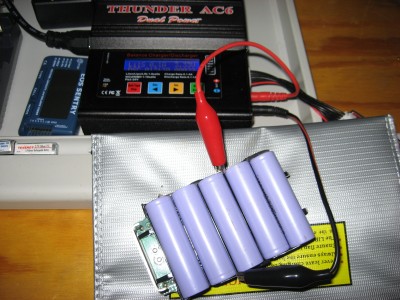
In the image above, I have isolated a cell and set my hobby charger to discharge it to 3.0 volts.
Here are the voltages after discharging: 3.48v 3.47v 3.08v(the middle cell, fully discharged as shown in the above image) 3.48v 3.44v
Next I put the battery pack in the Ridgid charger to fully charge and see what happens.
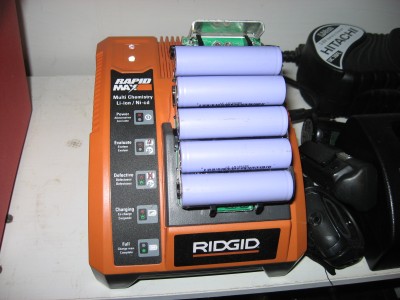
The green 'charged' light was light after only 30 minutes or so. Not a good sign; proper balance charging takes longer than that. I checked voltages: 4.15v 4.14v 4.07v(Too low. This was the discharged cell...it should be equal to the others if balanced) 4.15v 4.13v
So...bad news. The charging process does not seem to balance cells, at least not in the Ridgid chargers. This helps explain why people were complaining about battery life on the Ridgid company forums...not balancing a Li-Ion battery means shorter usage times and a quicker death for the pack.
As before, the voltages are low, indicating that the Hitachi drill battery is not getting topped off. After fulling charging each cell on my hobby charger to find the mAh levels, I calculated an extra 3-10 minutes of runtime for this small battery (depending on usage and tool) if it was completely full!
What else can you do to make the Li-Ion packs last longer? There are two variables under your control that can help: heat and storage charge. See the Wikipedia article here for full info, but to summarize:
- Keep your battery in a cool place. Even the refrigerator (not freezer!) is fine. Heat is bad, and not only discharges the battery at a faster rate, but hastens its demise.
- Storage charge. If you have multiple batteries, keep only one fully charged and the others slightly used up. This will increase their lifespan. Of course this only really applies to the casual user; if you are in construction or similar occupation and you swap 6 batteries a day, it isn't really feasible to keep them uncharged.
My overall verdict? If the battery packs were less expensive, they might be worth it to me. However, the higher cost combined with the sudden cut-off protection circuitry is too much to handle. Plus, Ridgid chargers don't balance or even top off the batteries, reducing their life and usage times. I will probably buy Ni-cad batteries next time. What is your take? Let me know your experience and results!